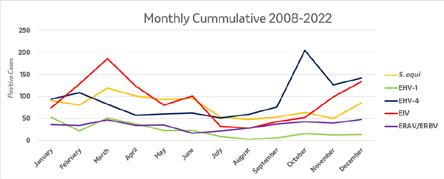
3 minute read
ASK THE EXPERT
Infectious Disease Expert
This column, brought to you by Merck Animal Health, features insightful answers from leading minds.
Insights from the ongoing Equine Respiratory Biosurveillance Program are constantly advancing. The program— which Merck Animal Health administers in partnership with the University of California, Davis, School of Veterinary Medicine (UC Davis)—boasts the largest contemporary biosurveillance data set in the United States, thanks to the participation of more than 260 veterinary clinics.
A recently published study, “Frequency of Detection and Prevalence Factors Associated with Common Respiratory Pathogens in Equids with Acute Onset of Fever and/or Respiratory Signs (2008-2021),” documents findings over a period of 13 years.1 During that time, 10,296 U.S. horses with acute onset of fever and respiratory signs were tested via nasal secretion (qPCR) for detection of equine influenza virus (EIV), equine herpesvirus-1 (EHV-1), equine herpesvirus-4 (EHV-4), equine rhinitis
A and B viruses (ERVs), and Streptococcus equi subspecies equi (S. equi).
STUDY HIGH POINTS:1
Clinical signs were similar between viral and bacterial respiratory infections, underscoring the importance of testing to confirm disease cause and proper management practices. Fever (>101.5°F) was the most frequently reported clinical sign (73% of cases), followed by nasal discharge (67.8%), lethargy (65.3%), anorexia (53.8%) and coughing (43.5%).

Figure 1. Comparing Seasonality Among Respiratory Pathogens (2008-2022)2
• Single infections were detected in 21.1% of total sample submissions.
• Multiple pathogens were detected in 2.7% of all samples submitted.
• Together, EIV and EHV-4 made up 63% of all single infections.
• S. equi was detected in 22%, ERV in 11% and EHV-1 in 4% of all positive samples.
• 76.2% of total samples were negative for all six primary pathogens tested.
• There was a distinct seasonality to EHV-4 (more likely in the fall), as well as to EIV and EHV-1 (more likely in the spring).
• Update: Figure 1 features the most current cumulative data (through 2022) on seasonality of infectious diseases since the paper was published.
• Viral infections were more common in young performance horses, while S. equi infections were more commonly found in older pleasure horses.
• When compared to all horses with known respiratory infections, clinical signs were fairly consistent across pathogens. However, coughing was a clinical hallmark of EIV infection
KNOWLEDGE IS POWER
Infectious disease trends equip you with information to better anticipate your patients’ risk factors and guide your recommendations for vaccination programs and biosecurity measures. To learn more about the Equine Respiratory Biosurveillance Program and to sign up to receive the biannual program newsletter, visit the Merck Animal Health Biosurveillance Program webpage.
1. Pusterla, N.; James, K.; Barnum, S.; Bain, F.; Barnett, D.C.; Chappell, D.; Gaughan, E.; Craig, B.; Schneider, C.; Vaala, W. Frequency of Detection and Prevalence Factors Associated with Common Respiratory Pathogens in Equids with Acute Onset of Fever and/or Respiratory Signs (2008–2021). Pathogens 2022, 11, 759. https://doi.org/10.3390/pathogens11070759.
2. Merck Animal Health and University of California, Davis (Nicola Pusterla). Infectious Upper Respiratory Disease Surveillance Program. Ongoing research 2008–present.
ABOUT THE AUTHOR
Duane E. Chappell, DVM, Associate Director, Equine Pharmacovigilance and Professional Services at Merck Animal Health, has a background in academia, equine research and private practice. Dr. Chappell and the Veterinary Professional Services team support the Equine Respiratory Biosurveillance Program by partnering with scientists at UC Davis to publish results.
WANT TO ASK A QUESTION? EMAIL THE EDITOR.
For more information, visit the Merck Animal Health Biosurveillance Program webpage.






